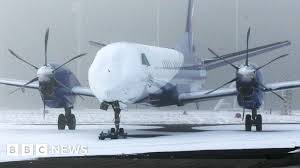**Why Does Britain Face Flight Chaos During Bad Weather?**
Britain's reputation for unpredictable weather is well-earned, and for its aviation sector, it presents unique challenges. Over the years, flight delays and cancellations caused by adverse weather conditions have become a recurring issue, frustrating travelers and exposing systemic vulnerabilities in the country’s aviation infrastructure. With experts warning that climate change could increase the frequency of extreme weather, such disruptions may become even more common in the future.
---
### **The British Weather Challenge**
The UK experiences a diverse range of weather patterns, often shifting rapidly due to its geographical location between the Atlantic Ocean and continental Europe. From dense fog and heavy rain to strong winds and snow, British weather has a significant impact on aviation.
- **Fog**: British airports, especially those in southern England, frequently grapple with fog. Low visibility makes it difficult for pilots to safely land or take off, even with modern navigation systems. Airports like London Heathrow, one of the world’s busiest, are particularly vulnerable because they operate at near capacity, leaving little room to absorb delays.
- **Wind**: Strong winds, particularly crosswinds, can make landings and takeoffs dangerous. Storms, like the infamous Storm Eunice in 2022, often force airlines to cancel flights as a precautionary measure.
- **Rain and Flooding**: Heavy rainfall can cause waterlogging on runways and affect ground operations. Prolonged periods of rain may also lead to flooding, disrupting airport access and services.
- **Snow and Ice**: While the UK doesn’t experience snow as frequently as some other countries, even a small amount can cause widespread disruption. The lack of snow-clearing equipment at some airports means that even light snowfall can lead to extended delays.
---
### **Why the UK Struggles to Cope**
1. **Capacity Constraints**:
British airports, particularly Heathrow, operate at near maximum capacity. This means that even minor weather-related delays can cause a domino effect, leading to cancellations and extended waits for passengers.
2. **Outdated Infrastructure**:
Many UK airports have aging infrastructure that struggles to cope with modern demands. Limited resources for de-icing planes or clearing snow from runways exacerbate the impact of adverse weather.
3. **Staffing Issues**:
Weather disruptions often coincide with staff shortages, particularly during peak travel periods. A lack of ground staff to assist with boarding, de-icing, or baggage handling can further delay flights.
4. **Air Traffic Control Limitations**:
The UK’s airspace is among the busiest in the world, and its air traffic control systems are under immense pressure. Bad weather compounds this by forcing controllers to increase the spacing between flights for safety, reducing the number of takeoffs and landings per hour.
5. **Over-Reliance on Heathrow**:
As Britain’s primary international gateway, disruptions at Heathrow often ripple across the entire aviation network. While other airports like Gatwick and Manchester serve international flights, none rival Heathrow’s capacity, making the system highly centralized and prone to bottlenecks.
---
### **The Climate Change Factor**
Climate change is expected to intensify the challenges posed by British weather. Experts predict an increase in extreme weather events, such as more frequent and severe storms, heavier rainfall, and unseasonal temperature fluctuations. These changes could make flight disruptions a regular feature of air travel in the UK.
For instance:
- **Rising Sea Levels**: Some coastal airports may face increased flooding risks.
- **Stronger Storms**: High winds and turbulence will make flying riskier, potentially leading to more cancellations.
- **Hotter Summers**: Heatwaves could affect runway performance, as extreme heat reduces air density, making it harder for planes to take off.
---
### **Steps Being Taken**
The aviation sector in the UK is aware of these challenges and has begun implementing measures to mitigate disruptions:
1. **Improved Weather Forecasting**:
Airlines and airports are investing in advanced weather prediction tools to better anticipate and prepare for adverse conditions.
2. **Upgraded Infrastructure**:
Some airports have started modernizing their facilities, including better drainage systems to handle heavy rainfall and additional equipment for snow and ice removal.
3. **Decentralization**:
The government is encouraging the use of regional airports to reduce reliance on Heathrow and spread out air traffic.
4. **Air Traffic Management**:
Efforts are underway to modernize air traffic control systems to improve efficiency and allow for better handling of delays during bad weather.
5. **Passenger Communication**:
Airlines are enhancing communication channels to keep passengers informed about delays, cancellations, and alternative travel options during disruptions.
---
### **What Can Passengers Do?**
While bad weather is beyond anyone’s control, passengers can take steps to minimize the impact of disruptions:
- **Book Early Flights**: Morning flights are less likely to be delayed since weather often worsens as the day progresses.
- **Check Weather and Flight Updates**: Stay informed about conditions at your departure and destination airports.
- **Travel Insurance**: Comprehensive travel insurance can provide financial protection in case of cancellations or long delays.
- **Pack Essentials**: Keep essentials like snacks, chargers, and a change of clothes in your carry-on luggage in case you’re stranded at the airport.
---
### **Conclusion**
Britain’s flight chaos during bad weather is a result of its unique climate, overburdened aviation infrastructure, and systemic inefficiencies. As climate change intensifies extreme weather, these disruptions may become more frequent and severe.
While steps are being taken to address the issue, a combination of public and private sector efforts will be needed to ensure that the UK’s aviation sector can weather the storms ahead—both literally and figuratively. For travelers, preparation and flexibility will remain key in navigating the challenges of flying in Britain’s unpredictable skies.


